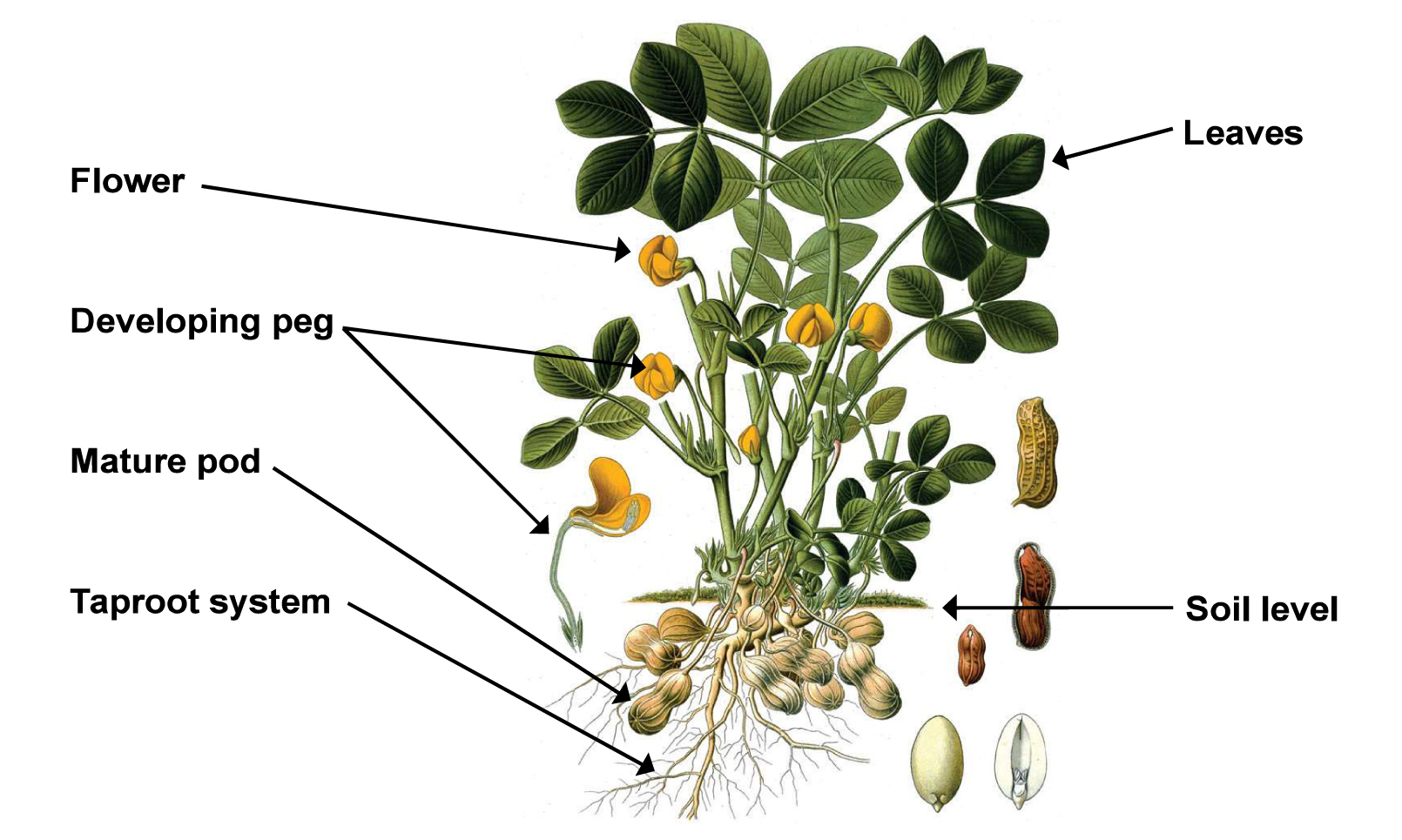July 2022
| DR WIKUS SNIJMAN, PROJECT MANAGER: GROUNDNUT BREEDER SEED, ARC-GRAIN CROPS |
 |
Groundnuts are primarily utilised for human consumption in terms of the raw seed, peanut butter, oil and other by-products. The correct cultivation of groundnuts can present farmers and consumers with a very high nutritional crop and a high-income value.
Locally, groundnuts are grown in the summer rainfall regions under irrigation and dryland conditions. Initially, smallholder farmers from mainly the northern and eastern parts of South Africa produced groundnuts for their own consumption; and it is still an important source of nutrition in the northern parts of KwaZulu-Natal and Mpumalanga.
Recently those farmers have entered the commercial market through incentives given by processors to boost South Africa’s production numbers and to keep the groundnut industry viable. This has opened many new business opportunities for the developing farmer and the commercial producer, where both parties are enabled to form strong working relationships to ensure a sustainable groundnut industry.
A groundnut breeding programme was started at Potchefstroom (ARC-GC) in the 1960’s, where Spanish-bunch type groundnut cultivars are currently still being produced (Figure 1).

An illustration of the groundnut plant.
BACKGROUND
Groundnuts (Arachis hypogaea L.) are divided into two groups, namely Virginia and Spanish-Valencia groups. The origin of groundnuts is from South America. It is safe to say that the groundnut legacy in South Africa was introduced by the Portuguese seafarers and slave traders in the form of the cultivar Natal-Common.
The importance of groundnuts for the South African market is emphasising its value nationally and as an export product, especially in terms of its potential to generate international revenue since 1967. Van der Merwe (1981) explained that the early Natal settlers conducted the first groundnut trials in 1853, when the locally available cultivar and the Virginia type favoured by the settlers were tested in South Africa.
This Spanish type is highly suitable for South African conditions because it is adapted to adverse environmental conditions, proved to be more disease resistant, supports a shorter growing cycle and shows an apparent lack of fresh seed dormancy, as suggested by Hammans in 1994.
STARTING YOUR OWN GROUNDNUT FARMING OPERATION
Soil
Soils normally selected for groundnut production should preferably be sandy. Groundnuts have a well-developed taproot system which, depending on the soil type, can reach a depth of 1,8 metres. Soils with a high potential to produce groundnuts are therefore typically deep (1 500 mm to 2 000 mm), well drained, red and/or yellow soils with a high fine sand fraction such as sandy loam to sandy texture in the topsoil. The pH (KCl) should range between 5,5 to 7.
The preparation of the seedbed is very important. The seedbed must be moist, even and firm to allow good contact between the soil particles and the seed for good germination and root development. Most important soils for groundnut cultivation are Avalon, Bainsvlei, Clovelly, Hutton and Glencoe. Physical limitations including shallow soil, hardpans or compaction layers must be avoided because it restricts taproot development.
Seed germination is rapid if the soil moisture and temperature are optimal (above 18°C). Shallow planted seeds (less than 50 mm deep) will be planted in relatively warmer soil. Seeds planted in too shallow soils will dry out quickly and germination will be low, which will result in poor stands.
Water
Areas under rainfed conditions in which groundnuts can be grown successfully, are limited because moisture is a critical factor for groundnut production. The Spanish type is recommended in these areas, as it is more water-use efficient (WUE) because of its upright growth habit and short growing season. Rainfall in the region of 500 mm to 700 mm per annum is optimum conditions for groundnut production.
Planting should not be done before at least 50 mm of rainfall in a short period of time was measured. The germination process of the seed can be speed up by planting them in moist, warm soils.
Temperature
Groundnuts originate from the tropical areas in South America and therefore require a growth period of at least 160 frost-free days and high temperatures. Avoid planting in dry soil and irrigate during cold spells or planting in cold, wet soil. Planting in soils of 15°C at a 5 cm soil depth ensures fast germination and produces healthy seedlings.
A germination rate of 95% can be achieved between 18°C to 30°C. Suitable vegetative growth occurs best between 20°C to 35°C, while a day temperature of 27°C is most suitable for flower development. A warm day of 29°C and a cool night of 23°C are optimum temperatures for pod formation.
Fertiliser
Groundnuts are not highly dependent on nitrogen fertilisation because, as a legume, it can fix atmospheric nitrogen with the aid of root bacteria that converts atmospheric N2 into NO-3 (nitrification). Active nitrogen nodules have a pinkish appearance and those not active are green when dissected. In rural fields, however, the level of phosphorous is usually low and it should be applied additionally.
Like other crops, groundnuts require adequate levels of potassium for normal growth and development. In the unlikely event where the potassium levels are low, it can be supplemented up to 10 kg ha-1. Calcium, on the other hand, is an essential element in groundnut production and crucial for seed development. An over-supply of potassium in the soil can induce a calcium deficiency. On calcium deficient soils, groundnuts will produce a lower yield with a low kernel quality.
Production practices
Planting starts when the soil moisture is adequate and after the seedbed has been properly prepared. To establish a good planting density, an amount of 50 kg seed is planted on a hectare.
On smaller pieces of land, the spacing of the seed in the row can be 8 cm apart and the spacing between the rows must be 90 cm. In high rainfall areas the spacing between the rows can be 75 cm.
The seed must be placed at a depth of 5 cm and a little pressure must be exerted on the planting row to maximise the contact between the soil and the seed. When implements are used for planting, the seed and fertiliser are deposited simultaneously. If hand planting is used, the fertiliser can be broadly and evenly spread by hand after planting.
The type of fertiliser is determined by the soil analysis. It is important to apply a pre-emergence herbicide, of which a mixture of Strongarm plus Alachlor can be recommended. Pest and insect control are usually not a major concern. However, when there is an infestation of 10% action should be taken. Usually aphids, rust and leaf spot are occurring more often than other problematic organisms.
To combat aphids, an insecticide with mercaptothion, pirimicarb or thiomefon as active ingredient can be applied. To control rust and leaf spot, the fungicides with active ingredients such as carbendazim or tebuconazole can be used. Maintenance of the groundnuts fields throughout the season is very important.
Harvesting takes place 150 days after planting. The whole plant gets lifted out of the ground and can be packed in a heap or placed in windrows to dry. After two weeks the leaves and stems can be removed, and the shelling can start. Care must be taken during the shelling process to prevent damage to the kernels. Split and damaged kernels will result in a lower income compared to whole (choice grade) kernels. The yield of groundnuts varies between 1,5 t ha-1 to 4 t ha-1.
Publication: July 2022
Section: Pula/Imvula